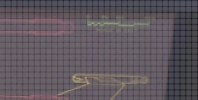It is sounding alot like you can't produce a photo of that scene from "The Enterprise Incident" from a CRT with the numbers legible. I'd be happy to see any photos to show otherwise.
That's not how this works. That's not how any of this works.
To review, you made the claim that no one could have discerned anything out of "The Enterprise Incident" diagram as aired (while also arguing that we should notice the minor differences in the drawing versus the eleven foot model and consider them reason to disregard the drawing, with no apparent thought given to the self-contradiction inherent in that juxtaposition). Therefore, you seem to argue, the diagram isn't canon or doesn't count or something.
I pointed out that you might not be wrong about the visibility insofar as the words (i.e. "SCALE IN FEET"), but that (a) the numbers on the scale chart are comprehensible and (b) your images are not proof of your claim because they are uniquely unclear with missing imagery elements on the areas of interest, compared to non-text areas in the same photo.
I did not suggest that (b) was intentional on your part. After all, taking a picture with missing lines in an attempt to prove that something cannot be read would be very dishonest, and I am sure that was not your intent. I'm sure you also didn't mean to further challenge someone who pointed out this problem to go get their own CRT rather than actually prove the claim with complete images. That could be viewed as even less scrupulous insofar as it could represent an attempt to shift the burden of proof while refusing to acknowledge that the claim is unproven.
Rather than continue down that hole, I'd be tempted to stipulate that the chances of someone discerning the words on the diagram in the period 1968-1985 on NTSC televisions without additional information were very low, in the absolute best case, or completely zero, at worst. That said, someone familiar with engineering sketches and used to scale diagrams of the type might've made a convincing argument for "XXXXX XX XXXX" next to an obvious scale marker being "SCALE IN FEET" -- were it not for them having the diagram in hand from the bookstore in 1968 short-circuiting any such need -- so your mileage may vary.
(The natural follow-up either way is "what of it?" It doesn't change the fact that it was in the episode, readable in a standard definition releases, along with being known to everyone at the time. I am all for a high burden of proof in regards to arguments from canon details, but the reality of 1968–1985 was that you've get Greg Jein types optically blowing up film cels for blurry mimeographed fanzines for impressed readers, not debating whether they could really see it when they watched.
Even if it wasn't "canon-to-the-viewer" until VHS or Laserdisc releases or 1999 DVD releases, so what? That doesn't make it non-canon.)
Similarly, no one is suggesting regarding (a) that the digits are perfectly clear and readable on your small CRT image. What is true, however, is that anyone who has been trying to read tiny text from screens ever would know that one uses one's brain in such scenarios. If I see a picture of a Constitution Class ship and a blurry XXX Xxxxxxxxxx beneath and NCC-1701 on the hull, I don't have to be able to mindlessly read the text to be able to reasonably assert that it says USS Enterprise. As before, I am equally certain that intentional obfuscutory obtuseness mixed with a demand for absolute 100% crystal clarity of evidence from your opponent wouldn't be your standard of behavior.





 Those weren't original broadcast conditions.
Those weren't original broadcast conditions.
